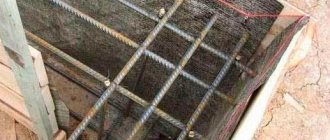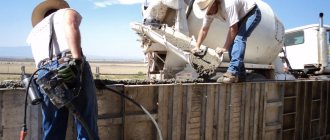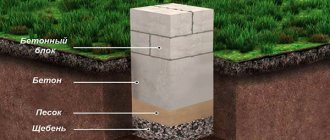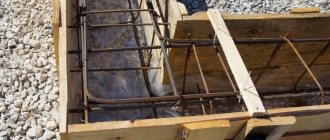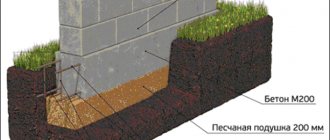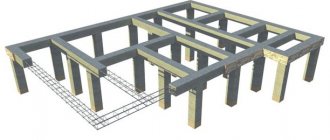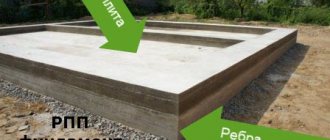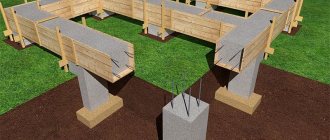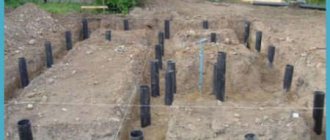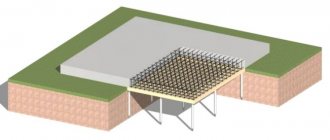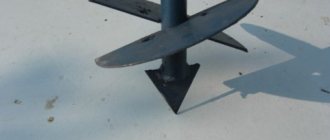Composite reinforcement is one of the modern materials designed to replace expensive rolled metal and provide greater resistance to the negative influence of external factors. After this type of polymer rod began to be produced in Russia in 2012, interest in it from builders began to increase every year.
The use of fiberglass materials for the reinforcement of monolithic concrete structures is especially important in cases of possible exposure to moisture, since polymers are not susceptible to corrosion.
Plastic rods are used at individual development sites, during the construction of large buildings and structures, for coastal fortifications and highways. In private construction, it is used to make reinforcing frames for strip and slab foundations, and also to reinforce masonry made of foam concrete blocks.
The material from which plastic fittings are made is a polymer mixture of longitudinal fiberglass of increased strength and thermally resistant resin. Standard diameters of produced rods range from 4 to 32 mm. Maximum operating temperature 60˚C. Tensile strength 150 MPa.
Preparation of materials for assembling the reinforcing frame
To increase the overall strength of a concrete monolith, it is reinforced with a structure made of fiberglass reinforcement in the form of a flat mesh or spatial frame, which is assembled from round rods of variable or constant cross-section. The individual elements of such structures are connected to each other using binding wire, fixing clamps or a special gun.
Therefore, to knit a reinforcing frame you need to purchase:
- plastic fittings of designed diameters;
- tie wire or tie clamps.
Unlike traditional metal rods, fiberglass reinforcement is supplied in the form of a coiled coil.
Therefore, before starting to assemble the frame, it must be unwound and cut into pieces of the required length. Cutting is done with a hacksaw or other tool that does not allow the material to heat up. Marking cut locations on the surface can be easily done using an ordinary marker.
The binding wire must be round in cross-section and have a diameter of at least 1 mm to ensure the necessary strength of the connection and not burst when twisted. To quickly obtain pieces of wire of the length required for knitting, the entire rolled coil must be cut into 3 or 4 parts with a grinder.
To make the binding wire softer, it can be burned in a flame using a blowtorch or in a fire. Unburnt wire bends worse and does not always provide a tight grip on the joint. In addition, unprepared metal has less ductility and is more likely to break during operation.
Knitting with clamps.
General knitting pattern.
Is it possible to use fiberglass reinforcement for foundation construction?
Rods are manufactured in the diameter range of 4-32 mm. The most popular products are with diameters of 6, 8, 10 mm.
Characteristics of fiberglass rods:
- The low specific weight and sale of the material in coils greatly facilitate its transportation and installation.
- Corrosion resistance. Thanks to this property, glass composite rods can be used in contact with aggressive environments without additional anti-corrosion measures.
- No coefficient of thermal conductivity. When laying reinforcing bars in concrete structures, which are additionally protected by thermal insulation materials, this characteristic is not important.
- No electrical conductivity. In the construction of residential buildings, this property does not play a special role. Moreover, in some reinforced concrete structures, special conclusions are made from the reinforcement for lightning protection or as an element of the grounding loop.
The use of this building material for reinforcing foundations has limitations due to a number of properties, including:
- Inability to bend the rods yourself at the construction site. This can only be done in a production environment. The solution is to make an angle by tying the rods together with steel binding wire or clamps.
- Weak resistance to elevated temperatures.
- Low fracture strength and poor resistance to tensile loads. Glass-composite rods are definitely not used to reinforce floor slabs and beams.
- Little experience in reinforcing foundations with composite reinforcement and a weak regulatory framework. There is no reliable information about the long-term use of this material. Elements of composites are subject to “aging”, so it is impossible to predict their behavior in the long term.
Many civil engineers believe that the use of fiberglass reinforcement for foundation reinforcement is justified only in cases where thermal conductivity and dielectric properties are important.
Wire tying tool
Using pliers for knitting is not very convenient. They do not provide the required connection coverage density and require a lot of effort. Therefore, steel wire is twisted onto reinforcing bars using special hooks or a knitting gun. Tool stores offer for sale two types of hooks designed for tying reinforcement:
- simple manual ones, which must be rotated all the time during operation;
- semi-automatic screw type, with a hook that rotates when you press the handle;
- plastic fasteners in the form of rings and vertical posts that fit onto the reinforcement.
Instead of buying a simple hook, you can make it yourself (read more about how to do this here), bending it from thick steel wire and sharpening the tip. In this case, you will have something to knit a project design from rods without purchasing a tool.
Technology of manual wire knitting of fiberglass reinforcement
In order for the reinforcement frame or mesh to take on the required spatial shape and not change it when concrete is poured, all individual elements must be securely connected to each other. The most common way to do this is to use tie wire. Knitting is a simple and quick joining method that does not require high qualifications. In addition, fiberglass reinforcement simply cannot be connected by welding, and therefore this type of fastening is most suitable in this case.
The entire process of how to knit fiberglass reinforcement for a foundation can be divided into the following step-by-step steps:
- the reinforcement rolled into a coil is unwound and cut into pieces of the designed length;
- plastic clamps are put on the transverse rods of the lower reinforcing layer;
- longitudinal rods are laid on the spaced transverse elements at a specified distance from each other;
- at all intersections of the reinforcement, connections are made by twisting loops of knitting wire folded in half;
- after assembling the bottom row, vertical reinforcing elements are tied to the intersections of the outer cells;
- transverse sections are tied to the upper ends or to the middle of the vertical posts, depending on the design number of rows;
- the next row of longitudinal reinforcement is laid and knitted;
- the assembled frame is transferred and installed inside the formwork for the strip foundation.
The work can be greatly simplified if you combine fiberglass reinforcement with metal. You can prepare rectangular frames from steel rods in advance and then you will not need to perform separate knitting of vertical sections.
Advantages and disadvantages
Fiberglass reinforcement is an excellent option for strengthening the foundation. This material increases its strength, increases service life and allows it to withstand high loads.
If you are thinking which reinforcement is better - fiberglass or metal, it is worth considering the important positive features of composite reinforcement over steel :
- a light weight. Compared to metal products, composite reinforcement is 9 times lighter. For this reason, you do not need to use special expensive equipment to install it;
- fiberglass elements are highly resistant to chlorine and other acidic, aggressive substances. Compared to steel products, the stability coefficient of composite products is 10 times higher;
- low level of thermal conductivity. Due to the fact that the reinforcement heats up and cools down, it does not cause destruction of the internal part of concrete structures;
- Composite products have the properties of dielectric non-conductivity and electromagnetic permeability. This means that they cannot conduct electricity and do not interfere with radio waves;
- have tensile strength. Compared to metal, it is 2-3 times higher;
- increased resistance to corrosion;
- easy transportation;
- low price. Compared to metal products, fiberglass rods are much cheaper.
Do not forget about the disadvantages of composite products:
- Fiberglass reinforcement has a low modulus of elasticity and can be easily bent. During the construction of the foundation and paths, this drawback is not noticeable. But if the products are used in the construction of floors, then this nuance should not be missed; it is important to carry out all the necessary calculations;
- The products have an insufficient level of heat resistance. You should not combine fiberglass reinforcement with concrete mortar under strong temperature changes, otherwise it may completely lose its binding properties;
- fragility. Over time, composite products wear out and begin to deteriorate; exposure to an alkaline environment also has a huge impact on rapid wear. But manufacturers, in order to increase the service life of fiberglass reinforcement, began to add rare earth metals to its composition;
- not intended for welding.
The nuances of knitting structures for pouring a slab foundation
Reinforcement of monolithic slab-type support bases is carried out in the form of one or two rows of meshes, depending on the design solution. Therefore, in this design, reinforcing bars are not considered as longitudinal and transverse. To raise the lower mesh above the waterproofing layer, plastic clamps are placed on the reinforcement every one and a half to two meters. This allows you to install the reinforcement cage strictly in a horizontal plane at a given height.
An important feature of assembling reinforcement for a slab foundation is that it is produced locally. This is necessary due to the large size of the structure and the impossibility of subsequent movement. Therefore, during knitting, you must be extremely careful not to step on the laid reinforcing bars and damage the structure.
In the Swedish and Finnish insulated slab (more about it in this article), it is necessary to provide for the intersection of the slab rods with the reinforcing frame of the side support strip. To do this, the rods are cut longer, placed on vertical side reinforcement frames and tied with wire.
The nuances of knitting fiberglass frames for strip foundations
Features of the assembly of reinforcement for strip foundations include the presence of lateral junctions, intersections and corners.
In places where the tapes meet under the internal walls, the connection of the perpendicular frame with the external one is made using bent U-shaped elements.
In the corners, the reinforcement is bent at a right angle or prepared L-shaped elements are tied. The overlap length of the connected rods must be at least 30 cm and at least 2 knits are performed in this area.
Fiberglass reinforcement should be bent very carefully, without using heat treatment. The elastic properties of plastic make the bending procedure quite difficult. Therefore, to assemble corners and junctions, it is recommended to buy prefabricated bent elements.
The intersections of fiberglass reinforcement under the strip foundation can be connected by straight sections or one of the intersecting structures can be assembled at the installation site.
Construction of a strip foundation with fiberglass reinforcement
For the construction of slab foundations for heavy buildings, glass-composite reinforcement is not used. Such rods can only be used in the construction of strip foundations. But even in this case, it is recommended to carry out careful engineering calculations taking into account the planned loads on the foundation of the house, soil characteristics and the proximity of groundwater to the surface. In the case of close proximity to groundwater and the presence of heaving, subsidence soils, it is recommended to use steel reinforcement. Even an experienced designer will not always be able to accurately determine the feasibility of using composite reinforcing material for the foundation due to the lack of appropriate SP and SNiPs.
